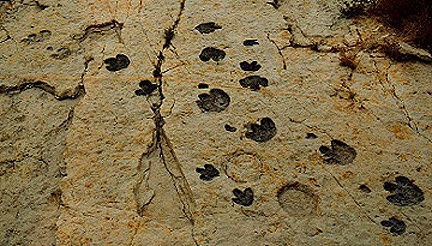



| Dinosaur tracks are fascinating reminders to see, as both adults and children enjoy comparing the size of their foot to foot impressions left behind by dinosaurs. Here are a few examples of what dinosaur tracks look like. |
 |
| Because dinosaurs traveled, evidence of their movements are preserved
as tracks and trackways. A track is the impression left by a foot in a
sediment or other substrate. Some two-legged dinosaurs also made
" front hand" or forelimb impressions and these are also considered tracks.
The two main ways tracks are preserved are as impressions which are molds
of the original foot, and casts which, are made when overlying sediments
fills in the original impressions. Some dinosaurs were also so heavy the
deformed layers of sediment below the surface. Such impressions are
called undertracks because they were under the original track surface.
Trackways are where two or more consecutive tracks are made by the same animal. Many mammals and birds leave a walking trackway today. Modern birds often leave their trackways along beaches and lakes. It is not uncommon to find raccoon tracks along a stream or pond. In time, some of this modern tracks and trackways may be fossilized in much the same way as did the dinosaur tracks and trackways. All dinosaurs seemingly were diagonal walkers. Dinosaur trackways show no evidence of either tail or belly dragging, meaning that dinosaurs walked erect with their limbs underneath their bodies, rather than sprawled to the sides of the body. Some dinosaurs were bipedal but most were quadrupedal. Different types of dinosaurs left distinctive tracks that can be attributed
to general classifications, such as ceratopsians, theropods, ornithopods,
or sauropods. Tracks rarely provide enough information or details
to identify the genus or species of the trackmaker, such as Tyrannosaurus,
Apatosaurus, or Triceratops. However, tracks and trackways, represent valuable
information about what dinosaurs lived in an area during certain times,
how they evolved, how individuals behaved, and how they interacted.
In the trackways located at Dinosaur Valley State Park in Texas, it appears
that a quadrupedal herbivorous dinosaur (sauropod) was being followed by
a bipedal carnivorous dinosaur (theropod), so was the theropod after the
sauropod for something to eat?
|
 |
| The first dinosaurs are thought to have been bipedal descendants of
archosaurs which evolved during the Triassic Period. Dinosaur tracks
from the Late Triassic show bipedalism and support this idea. These tracks
have a three-toed shape characteristic of theropods from the Late Triassic
through the Late Cretaceous Periods. All theropods were obligate bipeds,
although some rare examples of trackways show that they went down onto
all fours, meaning some of them were facultative quadrupeds. Some tracks
show claw impressions at the ends of toes. Theropods trackways show little
deviation from the midline of travel, as if they were walking on a tightrope.
Ornithopods were also capable of leaving bipedal trackways but were mostly facultative bipeds. Their tracks are similar to those of theropods in that they frequently show a three-toed pattern; they differ from theropod tracks in the width of the individual toe prints, which are greater than those of theropods. Ornithopod tracks are present in deposits from the Jurassic through the Late Cretaceous but are particularly common in Late Cretaceous deposits. Hadrosaurs are probably the best known ornithopods that left tracks attributable to the trackmaker.  Some quadrupedal ornithopods have three-toed tracks for their pes impressions but manus prints do not show obvious toes, either. Prosauropods, ceratopsians, ankylosaurs, and possibly stegosaurs left four-toed impressions in their tracks, both for the manus and pes. Sauropods have five-toed tracks for their pes impressions but do not show toes in manus impressions. To help you in locating dinosaur tracks to visit, we have provided some of the locations where dinosaur tracks can be seen. To learn where these sites are, and links to some dinosaur track location, just link on the icon below.
|

 RETURN TO THE HISTORY HOUSE HOME PAGE
RETURN TO THE HISTORY HOUSE HOME PAGE



![]()

This page enhanced by Wild Willy's Web Pages